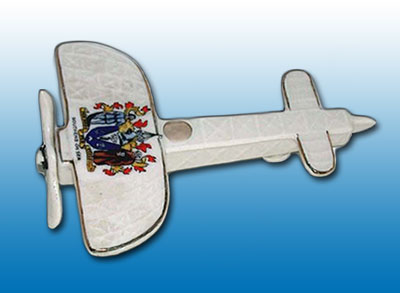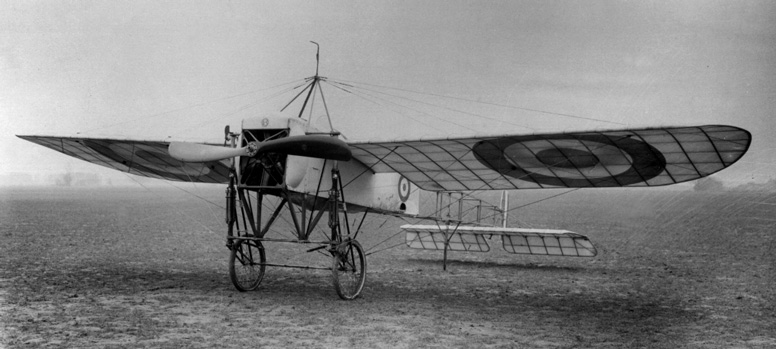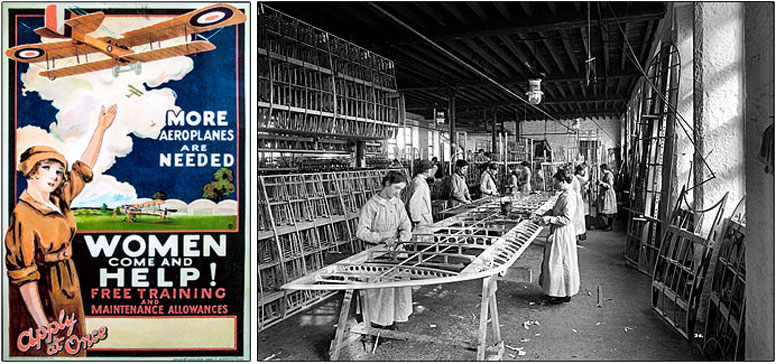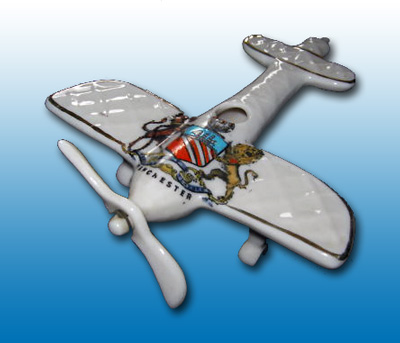
A tribute to all who died & suffered as a consequence of World War 1.
This is the ninth of a series of articles featuring Carlton China models relating to the war.
Part 9 - Aeroplanes
Three models of aeroplanes were made in Carlton China. Before we show you these, below are two military posters featuring biplanes and monoplanes from the time of the War.

Left - RAF recruitment poster c.1918.
Right - German propaganda poster "What England Wants" showing swarms of British planes bombing a factory - 1918.

Carlton China model of a monoplane based on the Blériot XI.
The propeller is separate from the body and rotates. I have also seen pictures of an example with rotating front wheels, though this might be a repair.
It is possible that this model was made before WW1, though there is no evidence of this. Wiltshaw & Robinson, makers of Carlton China, could have produced it to mark the 1909 Channel crossing.

RFC Blériot XI monoplane c1916. Before WW1, Blériot opened flying schools at Brooklands in Surrey and at Hendon Aerodrome.
For lightness and strength, the early aeroplanes were made from fabric covered wood. Below is a picture of women making wings for biplanes at Waring & Gillow's requisitioned furniture factory in Lancaster. Notice that the Carlton China models also show the complex ribbed construction.

Left - British recruitment poster from 1918.
Right - Women working on bi-plane wings at Waring & Gillow's furniture factory in Lancaster requisitioned during WW1.

Carlton China monoplane with circular cross section fuselage.
These are characteristics of several monoplanes, notably the Bristol M1, shown below. Also of conventional wood and fabric construction, it was first ordered by the War Office in 1916. However, the wing profile on the china model is the same as on the earlier Blériot, as is the horizontal tail, which is also missing a fin; the propeller also rotates.
Again the modeller must have worked from photographs, whatever craft it was based on, it is not surprising that there would be differences; accuracy would not have been that important.
Sometimes this model is found with the inscription:
Victory of Justice
Peace Signed at Versailles June 28 1918.

Left - Advertisement for the Bristol Military Monoplane from Flight Magazine February 1912.
Right - Bristol M1C monoplane made by British Colonial & Aeroplane Company Ltd.

Carlton China model of a Biplane with tail fin and roundel.
Rd.No. 657607.
The wing shape on the model is the same as on the previous two models. On the example shown right, a tail fin is present, though it is also found without the tail fin; possibly this was an earlier version, subsequently remodelled to include the fin.
Two sizes have been found and I am told of a version that has skis instead of wheels.
W&R, the makers of Carlton Ware and Carlton China, registered the design without a tail fin in 1916. It is the only model I have seen with the roundel that has been used on military aircraft since 1915.
Below are pictures of BE2s. In 1916, it was the first aircraft to bring down a Zeppelin, using new incendiary bullets designed to ignite the hydrogen filled airships. Conventional bullets had little effect.

Top Left - An observer adjusts the camera before a mission from a BE2c, a later development of the BE2. The pilot sat in the rear seat and observer in the front. Thanks to Steve Cox for this information.
Top Right - Post card of a BE2 at Farnborough.
Bottom - BE2 biplane designed and developed by the Royal Aircraft Factory c.1912.
Below the three aeroplanes are grouped together to show their differences. I wonder if Cuthbert Wiltshaw, the son of Frederick Wiltshaw, one of the three founders of Wiltshaw & Robinson, makers of Carlton China, flew any of the planes on which these were modelled? Cuthbert joined the Royal Flying Corp in 1917. He resigned his commission on 16 November 1918, 5 days after the end of the war, presumably to take over the running of the works after the death of his father in August 1918, three months before the hostilities ceased.

The three Carlton China models of aeroplanes.

In part 10, the next article, we look at airships.
This concludes our article on Carlton China models of aeroplanes.
Our next article, Part Ten, looks at Carlton China models of airships.
© Harvey Pettit 2014.
To email Harvey about this article .
Harvey Pettit © Copyright 2014. All rights reserved.